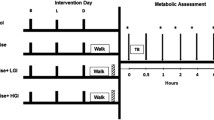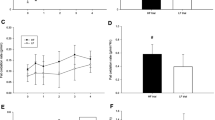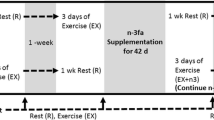Abstract
Our first aim was to investigate whether the ingestion of a single high-fat meal impairs glucose tolerance. Our second aim was to investigate whether improvements in glucose tolerance that are seen after resistance exercise remain when exercise is performed after ingestion of a high-fat meal. Eight young males consumed either a high fat (HF) or an isocaloric control (CON) meal in the morning and underwent an oral glucose tolerance test (OGTT) 6 h later. On two other occasions, a single 1 h bout of resistance exercise was completed 2 h after consumption of each meal (HFE and CONE). There were no significant differences in plasma glucose and plasma insulin areas under the curve (AUC) or estimates of insulin sensitivity between the HF and CON trials (P > 0.05). The HFE and CONE trials elicited a ~20% lower plasma glucose AUC (P < 0.05) compared to their respective control trials. The HFE also elicited a ~25% lower plasma insulin AUC (P < 0.05) in comparison to the HF trial. The HFE trial also significantly improved estimates of insulin sensitivity in comparison to the HF condition (P < 0.05). In conclusion, this study demonstrates that consumption of a single HF meal does not impair glucose tolerance in the resting state in lean individuals and that an acute bout of resistance exercise remains effective in enhancing glucose tolerance following the ingestion of a single high-fat meal.



Similar content being viewed by others
References
Bachmann OP, Dahl DB, Brechtel K, Machann J, Haap M, Maier T, Loviscach M, Stumvoll M, Claussen CD, Schick F, Haring HU, Jacob S (2001) Effects of intravenous and dietary lipid challenge on intramyocellular lipid content and the relation with insulin sensitivity in humans. Diabetes 50:2579–2584
Bae JH, Schwemmer M, Lee IK, Lee HJ, Park KR, Kim KY, Bassenge E (2003) Postprandial hypertriglyceridemia-induced endothelial dysfunction in healthy subjects is independent of lipid oxidation. Int J Cardiol 87:259–267
Bergman BC, Perreault L, Hunerdosse DM, Koehler MC, Samek AM, Eckel RH (2010) Increased intramuscular lipid synthesis and low saturation relate to insulin sensitivity in endurance-trained athletes. J Appl Physiol 108:1134–1141
Boden G, Jadali F, White J, Liang Y, Mozzoli M, Chen X, Coleman E, Smith C (1991) Effects of fat on insulin-stimulated carbohydrate metabolism in normal men. J Clin Invest 88:960–966
Boden G, Chen X, Ruiz J, White JV, Rossetti L (1994) Mechanisms of fatty acid-induced inhibition of glucose uptake. J Clin Invest 93:2438–2446
Clerk LH, Rattigan S, Clark MG (2002) Lipid infusion impairs physiologic insulin-mediated capillary recruitment and muscle glucose uptake in vivo. Diabetes 51:1138–1145
Creer A, Gallagher P, Slivka D, Jemiolo B, Fink W, Trappe S (2005) Influence of muscle glycogen availability on ERK1/2 and Akt signaling after resistance exercise in human skeletal muscle. J Appl Physiol 99:950–956
de Jongh RT, Serne EH, Ijzerman RG, de VG, Stehouwer CD et al (2004) Free fatty acid levels modulate microvascular function: relevance for obesity-associated insulin resistance, hypertension, and microangiopathy. Diabetes 53:2873–2882
Dresner A, Laurent D, Marcucci M, Griffin ME, Dufour S, Cline GW, Slezak LA, Andersen DK, Hundal RS, Rothman DL, Petersen KF, Shulman GI (1999) Effects of free fatty acids on glucose transport and IRS-1-associated phosphatidylinositol 3-kinase activity. J Clin Invest 103:253–259
Dreyer HC, Drummond MJ, Glynn EL, Fujita S, Chinkes DL, Volpi E, Rasmussen BB (2008) Resistance exercise increases human skeletal muscle AS160/TBC1D4 phosphorylation in association with enhanced leg glucose uptake during postexercise recovery. J Appl Physiol 105:1967–1974
Dunstan DW, Daly RM, Owen N, Jolley D, De Courten M, Shaw J, Zimmet P (2002) High-intensity resistance training improves glycemic control in older patients with type 2 diabetes. Diabetes Care 25:1729–1736
Ellis BA, Poynten A, Lowy AJ, Furler SM, Chisholm DJ, Kraegen EW, Cooney GJ (2000) Long-chain acyl-CoA esters as indicators of lipid metabolism and insulin sensitivity in rat and human muscle. Am J Physiol Endocrinol Metab 279:E554–E560
Essen-Gustavsson B, Tesch PA (1990) Glycogen and triglyceride utilization in relation to muscle metabolic characteristics in men performing heavy-resistance exercise. Eur J Appl Physiol Occup Physiol 61:5–10
Fard A, Tuck CH, Donis JA, Sciacca R, Di Tullio MR, Wu HD, Bryant TA, Chen NT, Torres-Tamayo M, Ramasamy R, Berglund L, Ginsberg HN, Homma S, Cannon PJ (2000) Acute elevations of plasma asymmetric dimethylarginine and impaired endothelial function in response to a high-fat meal in patients with type 2 diabetes. Arterioscler Thromb Vasc Biol 20:2039–2044
Fenicchia LM, Kanaley JA, Azevedo JL Jr, Miller CS, Weinstock RS, Carhart RL, Ploutz-Snyder LL (2004) Influence of resistance exercise training on glucose control in women with type 2 diabetes. Metabolism 53:284–289
Fluckey JD, Hickey MS, Brambrink JK, Hart KK, Alexander K, Craig BW (1994) Effects of resistance exercise on glucose tolerance in normal and glucose-intolerant subjects. J Appl Physiol 77:1087–1092
Fox AK, Kaufman AE, Horowitz JF (2004) Adding fat calories to meals after exercise does not alter glucose tolerance. J Appl Physiol 97:11–16
Frayn KN (2002) Adipose tissue as a buffer for daily lipid flux. Diabetologia 45:1201–1210
Giacco R, Clemente G, Busiello L, Lasorella G, Rivieccio AM, Rivellese AA, Riccardi G (2004) Insulin sensitivity is increased and fat oxidation after a high-fat meal is reduced in normal-weight healthy men with strong familial predisposition to overweight. Int J Obes Relat Metab Disord 28:342–348
Gosmanov AR, Smiley DD, Robalino G, Siquiera J, Khan B, Le NA, Patel RS, Quyyumi AA, Peng L, Kitabchi AE, Umpierrez GE (2010) Effects of oral and intravenous fat load on blood pressure, endothelial function, sympathetic activity, and oxidative stress in obese healthy subjects. Am J Physiol Endocrinol Metab. doi:10.1152/ajpendo.00469.2010
Harber MP, Crane JD, Douglass MD, Weindel KD, Trappe TA, Trappe SW, Fink WF (2008) Resistance exercise reduces muscular substrates in women. Int J Sports Med 29:719–725
Helmrich SP, Ragland DR, Leung RW, Paffenbarger RS Jr (1991) Physical activity and reduced occurrence of non-insulin-dependent diabetes mellitus. N Engl J Med 325:147–152
Hernandez JM, Fedele MJ, Farrell PA (2000) Time course evaluation of protein synthesis and glucose uptake after acute resistance exercise in rats. J Appl Physiol 88:1142–1149
Ibanez J, Izquierdo M, Arguelles I, Forga L, Larrion JL, Garcia-Unciti M, Idoate F, Gorostiaga EM (2005) Twice-weekly progressive resistance training decreases abdominal fat and improves insulin sensitivity in older men with type 2 diabetes. Diabetes Care 28:662–667
Ishii T, Yamakita T, Sato T, Tanaka S, Fujii S (1998) Resistance training improves insulin sensitivity in NIDDM subjects without altering maximal oxygen uptake. Diabetes Care 21:1353–1355
Itani SI, Ruderman NB, Schmieder F, Boden G (2002) Lipid-induced insulin resistance in human muscle is associated with changes in diacylglycerol, protein kinase C, and IkappaB-alpha. Diabetes 51:2005–2011
Johnson NA, Stannard SR, Rowlands DS, Chapman PG, Thompson CH, O’Connor H, Sachinwalla T, Thompson MW (2006) Effect of short-term starvation versus high-fat diet on intramyocellular triglyceride accumulation and insulin resistance in physically fit men. Exp Physiol 91:693–703
Kelley DE, Mokan M, Simoneau JA, Mandarino LJ (1993) Interaction between glucose and free fatty acid metabolism in human skeletal muscle. J Clin Invest 92:91–98
Koopman R, Manders RJ, Zorenc AH, Hul GB, Kuipers H, Keizer HA, van Loon LJ (2005) A single session of resistance exercise enhances insulin sensitivity for at least 24 h in healthy men. Eur J Appl Physiol 94:180–187
Koopman R, Manders RJ, Jonkers RA, Hul GB, Kuipers H, van Loon LJ (2006) Intramyocellular lipid and glycogen content are reduced following resistance exercise in untrained healthy males. Eur J Appl Physiol 96:525–534
Lewis GF, Carpentier A, Adeli K, Giacca A (2002) Disordered fat storage and mobilization in the pathogenesis of insulin resistance and type 2 diabetes. Endocr Rev 23:201–229
Liu L, Zhang Y, Chen N, Shi X, Tsang B, Yu YH (2007) Upregulation of myocellular DGAT1 augments triglyceride synthesis in skeletal muscle and protects against fat-induced insulin resistance. J Clin Invest 117:1679–1689
Marshall JA, Hoag S, Shetterly S, Hamman RF (1994) Dietary fat predicts conversion from impaired glucose tolerance to NIDDM. The San Luis Valley Diabetes Study. Diabetes Care 17:50–56
Matsuda M, DeFronzo RA (1999) Insulin sensitivity indices obtained from oral glucose tolerance testing: comparison with the euglycemic insulin clamp. Diabetes Care 22:1462–1470
Mayhew DL, Kim JS, Cross JM, Ferrando AA, Bamman MM (2009) Translational signaling responses preceding resistance training-mediated myofiber hypertrophy in young and old humans. J Appl Physiol 107:1655–1662
Melby C, Scholl C, Edwards G, Bullough R (1993) Effect of acute resistance exercise on postexercise energy expenditure and resting metabolic rate. J Appl Physiol 75:1847–1853
Ormsbee MJ, Thyfault JP, Johnson EA, Kraus RM, Choi MD, Hickner RC (2007) Fat metabolism and acute resistance exercise in trained men. J Appl Physiol 102:1767–1772
Pehleman TL, Peters SJ, Heigenhauser GJ, Spriet LL (2005) Enzymatic regulation of glucose disposal in human skeletal muscle after a high-fat, low-carbohydrate diet. J Appl Physiol 98:100–107
Perreault L, Bergman BC, Hunerdosse DM, Playdon MC, Eckel RH (2010) Inflexibility in intramuscular triglyceride fractional synthesis distinguishes prediabetes from obesity in humans. Obesity 18:1524–1531
Peters SJ, Harris RA, Wu P, Pehleman TL, Heigenhauser GJ, Spriet LL (2001) Human skeletal muscle PDH kinase activity and isoform expression during a 3-day high-fat/low-carbohydrate diet. Am J Physiol Endocrinol Metab 281:1151–1158
Plotnick GD, Corretti MC, Vogel RA, Hesslink R Jr, Wise JA (2003) Effect of supplemental phytonutrients on impairment of the flow-mediated brachial artery vasoactivity after a single high-fat meal. J Am Coll Cardiol 41:1744–1749
Praet SF, Jonkers RA, Schep G, Stehouwer CD, Kuipers H, Keizer HA, van Loon LJ (2008) Long-standing, insulin-treated type 2 diabetes patients with complications respond well to short-term resistance and interval exercise training. Eur J Endocrinol 158:163–172
Roden M, Krssak M, Stingl H, Gruber S, Hofer A, Furnsinn C, Moser E, Waldhausl W (1999) Rapid impairment of skeletal muscle glucose transport/phosphorylation by free fatty acids in humans. Diabetes 48:358–364
Schenk S, Horowitz JF (2007) Acute exercise increases triglyceride synthesis in skeletal muscle and prevents fatty acid-induced insulin resistance. J Clin Invest 117:1690–1698
Schenk S, Cook JN, Kaufman AE, Horowitz JF (2005) Postexercise insulin sensitivity is not impaired after an overnight lipid infusion. Am J Physiol Endocrinol Metab 288:519–525
Shaw CS, Clark J, Wagenmakers AJM (2010) The effect of exercise and nutrition on intramuscular fat metabolism and insulin sensitivity. Annu Rev Nutr 30:13–34
Shulman GI (2000) Cellular mechanisms of insulin resistance. J Clin Invest 106:171–176
Stettler R, Ith M, Acheson KJ, Decombaz J, Boesch C, Tappy L, Binnert C (2005) Interaction between dietary lipids and physical inactivity on insulin sensitivity and on intramyocellular lipids in healthy men. Diabetes Care 28:1404–1409
Venables MC, Shaw CS, Jeukendrup AE, Wagenmakers AJ (2007) Effect of acute exercise on glucose tolerance following post-exercise feeding. Eur J Appl Physiol 100:711–717
Vogel RA, Corretti MC, Plotnick GD (1997) Effect of a single high-fat meal on endothelial function in healthy subjects. Am J Cardiol 79:350–354
Wareham NJ, Wong MY, Day NE (2000) Glucose intolerance and physical inactivity: the relative importance of low habitual energy expenditure and cardiorespiratory fitness. Am J Epidemiol 152:132–139
Wojtaszewski JF, Nielsen JN, Richter EA (2002) Invited review: effect of acute exercise on insulin signaling and action in humans. J Appl Physiol 93:384–392
Yu C, Chen Y, Cline GW, Zhang D, Zong H, Wang Y, Bergeron R, Kim JK, Cushman SW, Cooney GJ, Atcheson B, White MF, Kraegen EW, Shulman GI (2002) Mechanism by which fatty acids inhibit insulin activation of insulin receptor substrate-1 (IRS-1)-associated phosphatidylinositol 3-kinase activity in muscle. J Biol Chem 277:50230–50236
Author information
Authors and Affiliations
Corresponding author
Additional information
Communicated by Jacques R. Poortmans.
Rights and permissions
About this article
Cite this article
Shaw, C.S., Cooper, N.M., Shaw, O. et al. Acute high-fat feeding does not prevent the improvement in glucose tolerance after resistance exercise in lean individuals. Eur J Appl Physiol 111, 2607–2613 (2011). https://doi.org/10.1007/s00421-011-1872-9
Received:
Accepted:
Published:
Issue Date:
DOI: https://doi.org/10.1007/s00421-011-1872-9




